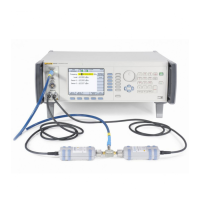96000 Series
Service Manual
2-4
Frequency Synthesis
Primary frequency synthesis takes place within the Synthesizer PCA
(Figure 2-3), where a combination of phase lock, frequency translation and direct
digital synthesis (DDS) techniques are used to generate signals of appropriate
resolution, phase noise and spectral purity. Four main outputs are created,
covering the ranges 20 kHz to 9 MHz, 1 GHz to 2.7 GHz, 2.7 GHz to 4 GHz and,
for wide deviation FM only, 62.5MHz to 125MHz. To achieve the required
frequency accuracy, these outputs are derived from a 10 MHz Oven Controlled
Crystal Oscillator (OCXO), but the instrument will also accept an external
reference clock source of between 1 MHz and 20 MHz in 1 MHz increments.
The four Synthesizer PCA output signals are fed to the RF Output PCA
(Figure 2-4) where additional frequencies are derived: frequencies covering the
range 9 MHz to 1 GHz (with the exception of wide deviation FM signals at carrier
frequencies below 125 MHz) are derived by applying signals of between 1 GHz
and 2 GHz to a binary divider chain, and frequencies spanning the range 1 mHz
to 20 kHz are generated by means of a wave table and associated DAC.
Frequencies covering the range 1 mHz to 4 GHz are thus available from the RF
Output PCA.
In the 96270A, frequencies above 4 GHz are generated on the 27 GHz Multiplier
PCA (Figure 2-6), by frequency multiplication of a 4-8 GHz signal from the
Synthesizer PCA to produce 4-27 GHz. There are four separate outputs from the
27 GHz Multiplier: 4-8 GHz, 8-12 GHz, 12-18 GHz and 18-27 GHz.
The 27 GHz Multiplier PCA (96270A) plugs into sockets on the 27 GHz Control
PCA (96270A), which supplies the required power supply and control signals.
The four outputs of the 27 GHz Multiplier connect via semi-rigid cables into a
coaxial SP6T switch, which is followed by an optional step attenuator and then
routed to the Microwave Output.
The 27 GHz Control PCA also contains the 300 MHz Frequency Counter
(96270A), which has 3 user-selectable input modes of operation: 50 MHz
(10 k), 50 MHz (50 ), and 300 MHz (50 ). The input is via a cable from a
dedicated BNC on the rear panel that is isolated from RF Common when the
300 MHz Frequency Counter is not in use.
Amplitude Control
Signals from the various sources are amplified, filtered and selected as
appropriate to produce a sinusoidal output at the required frequency.
To achieve the necessary dynamic range on the output, up to 138 dB of switched
attenuation, comprising 60 dB from coaxial attenuators (Figure 2-6) and 78 dB in
the Leveling Head (Figure 2-5), can be applied to the output signal. The 60 dB is
derived from three series 20 dB coaxial attenuators selected by a two way
coaxial multiplexer mounted on the left of the chassis.
In the 96270A there is another two way coaxial multiplexer (Figure 2-6), mounted
on the front bulkhead, that routes outputs below 4 GHz to the 27 GHz Control
PCA coaxial SP6T switch, optional step attenuator and then to the Microwave
Output. In the 96040A, when this two way multiplexer is not fitted, the coaxial
attenuators are connected directly to the Output PCA base leveled output.
For frequencies between 20 kHz and 4 GHz, the output amplitude is controlled
by a feedback loop which compares the output level with that of a set value and
maintains it by adjusting voltage-controlled attenuator circuits in the forward
signal path. At higher output levels all switched attenuation is applied within the
Leveling Head, and in this condition the signal level is sensed in the Leveling

